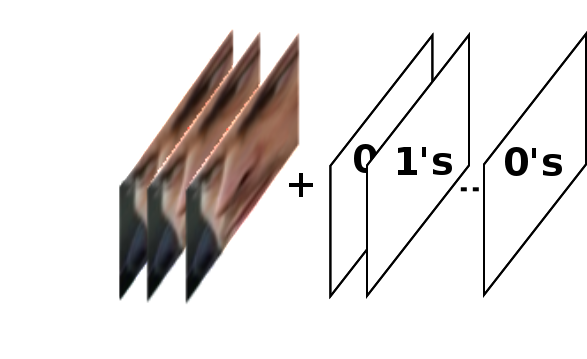Conditional GAN¶
The conditional GAN is an extension of the original GAN, by adding a conditioning variable in the process. As an illustration, consider MNIST digits: instead of generating a digit between 0 and 9, the condition variable would allow to generate a particular digit.
More particularly, the input to the generator (i.e. noise) will be concatenated with a variable specifying the particular condition to generate the fake data. Also, there are different strategies to embed the conditioning variable in the discriminator. Here we chose to concatenate the one-hot encoded conditional variable as feature maps to the input image.

Fig. 4 Conditional input to the discriminator¶
The article describing this algorithm is the following [cgan]:
@Misc{mirza-arxiv-2014,
Author = {Mirza, M. and Osindero, S.},
Title = {Conditional {G}enerative {A}dversarial {N}ets},
eprint = {arXiv:1411.1784},
seq-number = {49},
year = 2014
}
There are other articles dealing specifically with conditional GANs for face processing, and this work is loosely based on Conditional Generative Adversarial Nets for Convolutional Face Generation and inspired from the following code.
Here we consider the conditioning variable to be the pose of the face (in terms of yaw). We will use the Multi-PIE database, since it contains face images with 13 different poses.
First of all, we need to write a configuration file, containing the dataset and the network definition:
### DATA ###
from bob.learn.pytorch.datasets.multipie import MultiPIEDataset
from bob.learn.pytorch.datasets import RollChannels
from bob.learn.pytorch.datasets import ToTensor
from bob.learn.pytorch.datasets import Normalize
import torchvision.transforms as transforms
dataset = MultiPIEDataset(root_dir='path/to/multipie/data',
frontal_only=False,
transform=transforms.Compose([
RollChannels(),
ToTensor(),
Normalize((0.5, 0.5, 0.5), (0.5, 0.5, 0.5))
])
)
### NETWORK ###
from bob.learn.pytorch.architectures import ConditionalGAN_generator
from bob.learn.pytorch.architectures import ConditionalGAN_discriminator
from bob.learn.pytorch.architectures import weights_init
noise_dim = 100
conditional_dim = 13
generator = ConditionalGAN_generator(noise_dim, conditional_dim)
generator.apply(weights_init)
discriminator = ConditionalGAN_discriminator(conditional_dim)
discriminator.apply(weights_init)
Note
You should have the bob.db.multipie package installed on your environment. Note also
that this model acts on color images of face of size 64x64. It’s up to you to preprocess
your data to make them fit these constraints …
To train the conditional GAN to generate faces with different poses, you should execute:
$ ./bin/train_conditionalgan.py configuration.py -vv
If you have access to a GPU, you should run the script using this option:
$ ./bin/train_conditionalgan.py configuration.py -vv --use-gpu
Generated samples will be saved after each training epoch. You can specify where to write
images using the --output-dir option (default to ./conditionalgan).
Here are some examples of generated face images with different poses:

Fig. 5 After 1 epoch¶

Fig. 6 After 20 epoch¶

Fig. 7 After 50 epoch¶
- cgan
M. Mirza, S. Osindero. Conditional Generative Adversarial Nets arXiv:1411.1784.